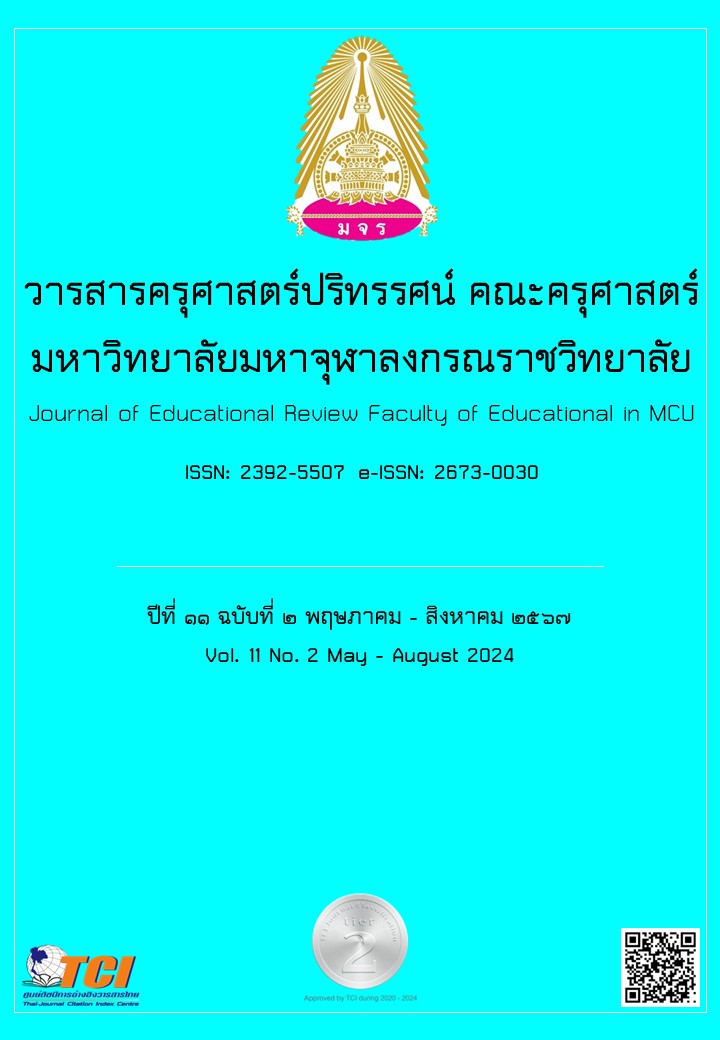DEVELOPMENT GUIDELINES OF CREATIVE LEADERSHIP OF SCHOOL ADMINISTRATORS AT NAKHONSAWAN PRIMARY EDUCATIONAL SERVICE AREA OFFICE 2 ACCORDING TO THE YONISOMANASIKĀRA
Main Article Content
Abstract
This research article aimed to 1) study the creative leadership of school administrators under the Nakhon Sawan Primary Educational Service Area 2 and 2) find a guideline for developing creative leadership of school administrators according to the principle of Yonisomanasikāra. This research was a mixed-method research. The quantitative research method collected data from a sample of 302 school administrators and teachers. The research instrument was a questionnaire with a reliability of 0.83. The data were analyzed by finding frequency, percentage, mean, and standard deviation. The qualitative research used a structured interview. The data were collected from 9 key informants and analyzed by content analysis. The research results showed that 1) The creative leadership of school administrators under the Nakhon Sawan Primary Educational Service Area 2 was at a moderate level overall. 2) The guideline for developing creative leadership of school administrators according to the principle of Yonisomanasikāra consisted of (1) in terms of adaptability, school administrators should be flexible in their work, understand the impact of change, and consider the development of the school in detail to support cooperation and beneficial change. They should consider learning from experience, considering mistakes, and finding solutions and understanding the current situation in order to solve problems and promote development in educational institutions. (2) In terms of teamwork, good administrators should have morality and be leaders who listen to opinions from the team. They should study and analyze events that affect the work, creating a problem-solving and decision-making process by separating the necessity and importance, and distinguishing issues in developing an understanding of the roles and work of administrators and others. (3) In terms of creativity, administrators should be able to think creatively to solve problems, consider advantages and disadvantages and find solutions, using experiences to develop themselves and be beneficial to others, distinguish and think logically in self-development. And (4) In terms of vision, administrators should be able to plan a vision for the development of educational institutions using the causal thinking method to create a problem-solving process and improving administration to be a good example and useful to personnel and applying experiences and knowledge to suit the current situation.
Article Details

This work is licensed under a Creative Commons Attribution-NonCommercial-NoDerivatives 4.0 International License.
ทัศนะและความคิดเห็นที่ปรากฏในบทความในวารสารฉบับนี้ถือเป็นความรับผิดชอบของผู้เขียนบทความนั้นเพียงผู้เดียว และไม่ถือเป็นทัศนะและความรับผิดชอบของกองบรรณาธิการ
กองบรรณาธิการขอสงวนสิทธิ์ในการคัดเลือกบทความลงตีพิมพ์และจะแจ้งให้เจ้าของบทความทราบหลังจากผู้ประเมินบทความตรวจอ่านบทความแล้ว
ต้นฉบับที่ได้รับการตีพิมพ์ในวารสารครุศาสตร์ปริทรรศน์ คณะครุศาสตร์ มหาวิทยาลัยมหาจุฬาลงกรณราชวิทยาลัย ถือเป็นกรรมสิทธิ์ของคณะครุศาสตร์ มหาวิทยาลัยมหาจุฬาลงกรณราชวิทยาลัย ห้ามนำข้อความทั้งหมดหรือบางส่วนไปพิมพ์ซ้ำ เว้นเสียแต่ว่าจะได้รับอนุญาตจากมหาวิทยาลัยฯ เป็นลายลักษณ์อักษร
References
กาญจนา ศิลา. (2556). การศึกษาภาวะผู้นำเชิงสร้างสรรค์ของผู้บริหารสถานศึกษาของโรงเรียนสังกัดกรุงเทพมหานคร สำนักงานเขตบางเขน. วิทยานิพนธ์การศึกษามหาบัณฑิต. มหาวิทยาลัยศรีนครินทรวิโรฒ.
กิตติกาญจน์ ปฏิพันธ์ จักรกฤษณ์ โพดาพล และวิลัยพร เสรีวัฒน์. (2556). ภาวะผู้นำเชิงสร้างสรรค์ : สิ่งควรค่าสำหรับทุกคนในอนาคต. ขอนแก่น: โรงพิมพ์คลังนานาวิทยา.
ดวงแข ขำนอก. (2559). การศึกษาภาวะผู้นำเชิงสร้างสรรค์ของผู้บริหารสถานศึกษา สังกัดสำนักงานเขตพื้นที่การศึกษานครราชสีมา เขต 6. วิทยานิพนธ์ครุศาสตรมหาบัณฑิต. มหาวิทยาลัยราชภัฏนครราชสีมา.
นัยนา ชนาฤทธิ์. (2556). ภาวะผู้นำเชิงสร้างสรรค์ของผู้บริหารสถานศึกษา สังกัดสำนักงานเขตพื้นที่การศึกษาประถมศึกษาขอนแก่น เขต 5. วิทยานิพนธ์การศึกษามหาบัณฑิต. มหาวิทยาลัยมหาสารคาม.
บุญชม ศรีสะอาด. (2560). การวิจัยเบื้องต้นฉบับปรับปรุง. พิมพ์ครั้งที่ 9. กรุงเทพมหานคร: สุวีริยาสาส์น.
บุญช่วย สายราม. (2563). ทักษะผู้นำองค์กรโรงเรียนศตวรรษที่ 21. แหล่งที่มา https://www.gotoknow.org/posts/565807. สืบค้นเมื่อ 10 ก.ค. 2563.
ปถมพร ตะละภัฎและคณะ. (2560). ศึกษาวิเคราะห์การคิดเชิงบวกในการพัฒนาชีวิตตามหลักพระพุทธศาสนา. วารสารบัณฑิตศึกษาปริทรรศน์. 13(3). 280-291.
ปราโมทย์ พูลเพิ่ม. (2560). ความคิดเห็นของครูเกี่ยวกับภาวะผู้นำเชิงสร้างสรรค์ของผู้บริหารสถานศึกษาสำนักงานเขตบางบอน กรุงเทพมหานคร. วิทยานิพนธ์การศึกษามหาบัณฑิต. มหาวิทยาลัยรามคำแหง.
พระครูพิศิษฎสรคุณ สะใบบาง. (2561). รูปแบบการนิเทศภายในสถานศึกษาขั้นพื้นฐานตามหลักโยนิโสมนสิการ. การศึกษาค้นคว้าด้วยตนเองการศึกษามหาบัณฑิต. มหาวิทยาลัยพะเยา.
พระพรหมคุณาภรณ์ (ประยุทธ์ ปยุตโต). (2549). วิธีคิดตามหลักพุทธรรม. กรุงเทพมหานคร: พัศยาม.
ภรณ์ทิพย์ ปั้นก้อง. (2559). ภาวะผู้นำเชิงสร้างสรรค์ของผู้บริหารโรงเรียน สังกัดสำนักงานเขตพื้นที่การศึกษาประถมศึกษาชลบุรี เขต 3. วิทยานิพนธ์การศึกษามหาบัณฑิต. มหาวิทยาลัยบูรพา.
สมชาย เทพแสง. (2559). กลยุทธ์ของผู้นำร่วมสมัย. กรุงเทพมหานคร: วิทยาลัยเทคโนโลยีดอนบอสโก.
สาคร สุขศรีวงศ์. (2553). การจัดการ : จากมุมมองของนักบริหาร. กรุงเทพมหานคร: จี.พี.ไซเขอร์ พริ้นท์.
สำนักงานเขตพื้นที่การศึกษาประถมศึกษานครสวรรค์ เขต 2. (2565). รายงานผลการดำเนินงาน ประจำปีงบประมาณ 2565. นครสวรรค์: สำนักงานเขตพื้นที่การศึกษาประถมศึกษานครสวรรค์ เขต 2.
สำนักงานคณะกรรมการการศึกษาแห่งชาติ. (2545). พระราชบัญญัติการศึกษาแห่งชาติ พ.ศ. 2542 และที่แก้ไขเพิ่มเติม (ฉบับที่ 2) พ.ศ. 2545. กรุงเทพมหานคร: พริกหวานกราฟฟิค.
สุภาพ ฤทธิ์บำรุง. (2556). ภาวะผู้นำเชิงสร้างสรรค์ของผู้บริหารสถานศึกษา ที่ส่งผลต่อความมีประสิทธิผลของโรงเรียน สังกัดสำนักงานเขตพื้นที่การศึกษามัธยมศึกษาเขต 30. วารสารศึกษาศาสตร์ ฉบับวิจัยบัณฑิตศึกษา มหาวิทยาลัยขอนแก่น. 8(2). 190-192.
อาภา จันทรสกุล และคณะ. (2556). การสร้างแบบวัดวิธีคิดแบบโยนิโสมนสิการสำหรับนักศึกษาระดับอุดมศึกษา. รายงานการวิจัย. มหาวิทยาลัยเกษตรศาสตร์.
Keeves, Peter J. (1988). Model and Model Building: Educational Research Methodology and Measurenment : An Intermational Handbook. Oxford: Pergamon Press.
Krejcie, R. V. & Morgan, D. W. (1970). Determining sample size for research activities. Educational and Psychological Measurement. 30(3). 607–610.


